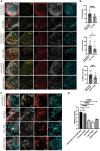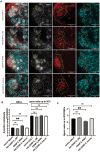Centromere proteins are asymmetrically distributed between newly divided germline stem and daughter cells and maintain a balanced niche in Drosophila males
- PMID: 36920070
- PMCID: PMC10162413
- DOI: 10.1091/mbc.E22-10-0466
Centromere proteins are asymmetrically distributed between newly divided germline stem and daughter cells and maintain a balanced niche in Drosophila males
Abstract
Stem cells can undergo asymmetric cell division (ACD) giving rise to one new stem cell and one differentiating daughter cell. In Drosophila germline stem cells (GSCs), the centromeric histone CENP-A (CID in flies) is asymmetrically distributed between sister chromatids such that chromosomes that end up in the GSC harbor more CID at centromeres. A model of "mitotic drive" has been proposed in GSCs such that stronger and earlier centromere and kinetochore interactions with microtubules bias sister chromatid segregation. Here we show that in Drosophila males, centromere proteins CID, CAL1, and CENP-C are asymmetrically distributed in newly divided GSCs and daughter cells in S phase. We find that overexpression of CID (either with or without CAL1) or CENP-C depletion disrupts CID asymmetry, with an increased pool of GSCs relative to daughter cells detectable in the niche. This result suggests a shift toward GSC self-renewal rather than differentiation, important for maintaining tissue homeostasis. Overexpression of CAL1 does not disrupt asymmetry, but instead drives germ cell proliferation in the niche. Our results in male GSCs are comparable to female GSCs, indicating that despite differences in signaling, organization, and niche composition, the effects of centromere proteins on GSC maintenance are conserved between the sexes.
Figures







Similar articles
-
CENP-C functions in centromere assembly, the maintenance of CENP-A asymmetry and epigenetic age in Drosophila germline stem cells.PLoS Genet. 2021 May 20;17(5):e1009247. doi: 10.1371/journal.pgen.1009247. eCollection 2021 May. PLoS Genet. 2021. PMID: 34014920 Free PMC article.
-
Centromere assembly and non-random sister chromatid segregation in stem cells.Essays Biochem. 2020 Sep 4;64(2):223-232. doi: 10.1042/EBC20190066. Essays Biochem. 2020. PMID: 32406510 Review.
-
Asymmetric Centromeres Differentially Coordinate with Mitotic Machinery to Ensure Biased Sister Chromatid Segregation in Germline Stem Cells.Cell Stem Cell. 2019 Nov 7;25(5):666-681.e5. doi: 10.1016/j.stem.2019.08.014. Epub 2019 Sep 26. Cell Stem Cell. 2019. PMID: 31564548 Free PMC article.
-
Detrimental incorporation of excess Cenp-A/Cid and Cenp-C into Drosophila centromeres is prevented by limiting amounts of the bridging factor Cal1.J Cell Sci. 2010 Nov 1;123(Pt 21):3768-79. doi: 10.1242/jcs.067934. Epub 2010 Oct 12. J Cell Sci. 2010. PMID: 20940262
-
Centromere function in asymmetric cell division in Drosophila female and male germline stem cells.Open Biol. 2021 Nov;11(11):210107. doi: 10.1098/rsob.210107. Epub 2021 Nov 3. Open Biol. 2021. PMID: 34727723 Free PMC article. Review.
Cited by
-
Studying histone inheritance in different systems using imaging-based methods and perspectives.Biochem Soc Trans. 2023 Jun 28;51(3):1035-1046. doi: 10.1042/BST20220983. Biochem Soc Trans. 2023. PMID: 37171077 Free PMC article.
-
Adaptive evolution of CENP-T modulates centromere binding.Curr Biol. 2025 Mar 10;35(5):1012-1022.e5. doi: 10.1016/j.cub.2025.01.017. Epub 2025 Feb 12. Curr Biol. 2025. PMID: 39947176
-
Cellular and molecular mechanisms of asymmetric stem cell division in tissue homeostasis.Genes Cells. 2024 Dec;29(12):1099-1110. doi: 10.1111/gtc.13172. Epub 2024 Oct 8. Genes Cells. 2024. PMID: 39379096 Free PMC article. Review.
-
Old and newly synthesized histones are asymmetrically distributed in Drosophila intestinal stem cell divisions.EMBO Rep. 2023 Jul 5;24(7):e56404. doi: 10.15252/embr.202256404. Epub 2023 May 31. EMBO Rep. 2023. PMID: 37255015 Free PMC article.
References
-
- Bade D, Pauleau AL, Wendler A, Erhardt S (2014). The E3 ligase CUL3/RDX controls centromere maintenance by ubiquitylating and stabilizing CENP-A in a CAL1-dependent manner. Dev Cell 28, 508–519. - PubMed
-
- Carty BL, Dunleavy EM (2020). Centromere assembly and non-random sister chromatid segregation in stem cells. Essays Biochem 64, 223–232. - PubMed
Publication types
MeSH terms
Substances
Grants and funding
LinkOut - more resources
Full Text Sources
Molecular Biology Databases
Research Materials

